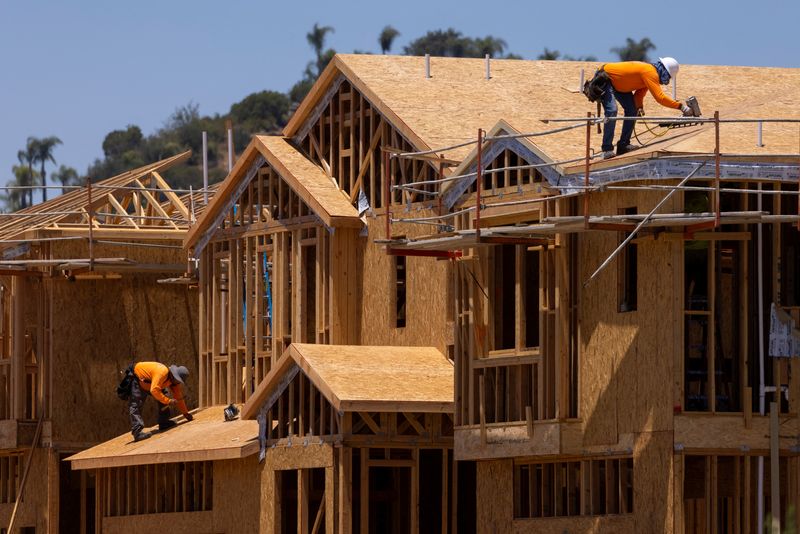Housing demand falls in U.S. due to expensive loans
2022.12.20 11:41
[ad_1]

Housing demand falls in U.S. due to expensive loans
Budrigannews.com – As higher mortgage rates continued to depress housing market activity, single-family homebuilding in the United States fell to a 2-1/2-year low in November and permits for future construction fell.
Tuesday’s pessimistic Commerce Department report came on the heels of Monday’s report that homebuilder confidence fell for a record-breaking 12th month in December.
It put residential investment on track to contract for the seventh quarter in a row, the longest stretch since the housing bubble burst, which started the Great Recession. As the U.S. central bank fights inflation, the housing market has been hit hardest by the Fed’s most rapid cycle of interest rate hikes since the 1980s.
Christopher Rupkey, chief economist at FWDBONDS in New York, stated, “The Fed’s rate hikes are doing what they are supposed to, further deepening the recession in the residential housing construction markets.” Builders of homes have nowhere to hide. The housing market is clearly in recession, regardless of the state of the economy as a whole.
Last month, starts on single-family homes, which make up the majority of new construction, decreased by 4.1% to a seasonally adjusted annual rate of 828,000 units. That was the lowest level since May 2020, when the first wave of the COVID-19 pandemic had hit the economy hard.
Outside the pandemic dive, single-family begins are the most fragile since February 2019. The South and Midwest, generally regarded as the more affordable regions of the United States, saw a decline in single-family home construction. It grew in the West and Northeast.
The rate of starts for housing projects with five or more units increased by 4.8 percent to 584,000, the highest level since April.
Due to the fact that many potential homebuyers are forced to remain renters as a result of the higher mortgage rates, the construction of multifamily homes is being driven by a strong demand for rental housing.
According to data from the mortgage finance agency Freddie Mac (OTC:), the 30-year fixed mortgage rate increased to above 7% a few months ago, marking the highest level since 2002. Even though the rate has fallen back to an average of 6.31 percent this week, it is still twice as low as it was at that point a year ago.
After the Federal Reserve indicated that additional rate increases would occur by the end of 2023, sending Treasury yields skyrocketing, rates could begin to rise. Treasury yields are correlated with mortgage rates.
Wall Street stocks were trading higher. The Bank of Japan’s decision to review its yield curve control policy and widen the trading band for the 10-year government bond yield shocked markets and caused the dollar to fall against a basket of currencies. The yields on the US Treasury rose.
Information on Monday showed certainty among single-family homebuilders sinking further in November, pushing the Public Relationship of Home Manufacturers (NAHB)/Wells Fargo real estate market record to the most minimal level since June 2012, barring the tumble during the beginning of the pandemic in the spring of 2020.
The leap in multi-family lodging projects offset a portion of the drag from single-family lodging units, bringing about by and large lodging begins falling simply 0.5% to a pace of 1.427 million units last month. Reuters polled a group of economists and found that the rate of starts would fall to 1.400 million units.
By lowering demand for everything from housing to labor, the Fed wants to slow inflation. Economists anticipate that, driven by the housing market, the labor market will begin to loosen and eventually weaken next year.
Six consecutive quarters have seen the housing market decline. This quarter, residential investment is anticipated to reduce GDP by as much as 0.7 percentage points.
The fourth quarter’s annualized growth rate is as high as 2.8 percent. The third quarter saw growth of 2.9% for the economy.
Gus Faucher, chief economist at PNC Financial (NYSE:), stated, “Housing will play a major role in the coming slowdown in the job market.” in Pennsylvania’s Pittsburgh. ” After quickly recovering from the pandemic, employment in residential construction has essentially remained flat over the past half year.”
The single-family real estate market blast from the get-go in the pandemic as Americans looked for greater properties to oblige work spaces. Apartments are now dominating the market.
However, multifamily housing is beginning to show signs of weakness. The rate of housing projects with five units or more receiving permits decreased by 17.9% to 509,000 units, which is the lowest rate since May 2021. Permits for single-family homes fell 7.1% to 781,000 units, the lowest level since May 2020.
In total, the number of permits issued for future home construction fell 11.2% last month to a rate of 1.342 million units, the lowest level since June 2020.
The number of houses that have been approved for construction but have not yet been built has decreased by 2.0 percent to 293,000 units. The backlog for the construction of single-family homes decreased by 3.4% to 143,000 units, but the rate of completions for this segment increased by 9.5% to 1.047 million units.
The inventory of single-family homes in the construction phase decreased by 1.3 percent to a rate of 777,000 million units, which is the lowest level since December 2021.
More U.S. Housing Construction Drops Hopes for 2023
The Fed faces a dilemma because higher mortgage rates, a decline in single-family home construction, and a decrease in inventory could exacerbate the existing housing shortage and slow down price declines.
According to economist Nicole Bachaud of Zillow in Seattle, “the limited available inventory fueled by both existing homeowners and homebuilders will keep the market tight, price declines minimal, and competition for desirable homes alive.”








